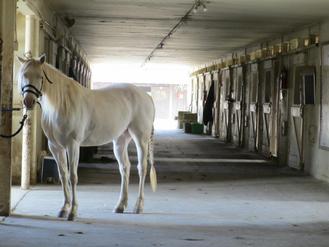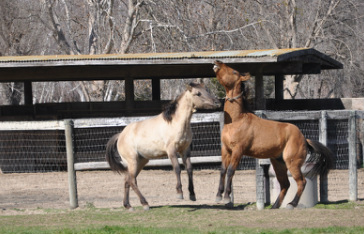Stables: |
|
Flooring
The material selected for flooring can greatly influence maintenance, as well as air quality.
Concrete: Easy to lay down, clean and maintain. Drainage can be a problem (though installing at a slant with drainage channels carved in can help) and is often cold as well as slippery. May require extra bedding.
Rubber Matting: Expensive but can provide an easy-to-clean and soft stall. Requires less additional bedding.
Wooden Flooring: Low maintenance. However, initial cost can be high and flooring can become slippery when wet.
Sand: Inexpensive, requires no additional bedding and provides excellent drainage. Needs to be cleaned and changed regularly. Also, increases the risk of colic!
Clay: Good drainage (especially when combined with sand), minimal odor, relatively economical, and fairly warm. However, clay requires a lot of maintenance and can also become slippery when wet.
Limestone Dust: Nearly as hard as concrete when packed but provides good drainage. Still requires additional bedding.
Concrete: Easy to lay down, clean and maintain. Drainage can be a problem (though installing at a slant with drainage channels carved in can help) and is often cold as well as slippery. May require extra bedding.
Rubber Matting: Expensive but can provide an easy-to-clean and soft stall. Requires less additional bedding.
Wooden Flooring: Low maintenance. However, initial cost can be high and flooring can become slippery when wet.
Sand: Inexpensive, requires no additional bedding and provides excellent drainage. Needs to be cleaned and changed regularly. Also, increases the risk of colic!
Clay: Good drainage (especially when combined with sand), minimal odor, relatively economical, and fairly warm. However, clay requires a lot of maintenance and can also become slippery when wet.
Limestone Dust: Nearly as hard as concrete when packed but provides good drainage. Still requires additional bedding.
Bedding
Things to consider when choosing a bedding type:
1. Cost: What is your budget? Certain bedding types last longer than others. Even though they may cost more initially, you may be saving money in the end.
2. Availability: Consider choosing a bedding which is widely available in your area as opposed to one that is produced seasonally or shipped in.
3. Storage: Do you have a large, covered area for loose bedding? Is there a loft for storing straw? Do you need to store things outside (consider bagged pellets)?
4. Disposal: How will you be disposing of it? Certain bedding types are easier to sell (some make better compost, for example).
5. Allergies: Do any of your horses have dust allergies or preexisting/chronic respiratory illnesses? If so, you would want to avoid certain bedding such as straw.
1. Cost: What is your budget? Certain bedding types last longer than others. Even though they may cost more initially, you may be saving money in the end.
2. Availability: Consider choosing a bedding which is widely available in your area as opposed to one that is produced seasonally or shipped in.
3. Storage: Do you have a large, covered area for loose bedding? Is there a loft for storing straw? Do you need to store things outside (consider bagged pellets)?
4. Disposal: How will you be disposing of it? Certain bedding types are easier to sell (some make better compost, for example).
5. Allergies: Do any of your horses have dust allergies or preexisting/chronic respiratory illnesses? If so, you would want to avoid certain bedding such as straw.
|
Disadvantages:
Stored undercover, often dusty, and some horses will eat it. Sometimes dusty, and can dry out the horse's hooves. Can be messy, soggy, and difficult to dispose of. Expensive, can become badly soiled (washable though). |
Feeders
Hay racks and nets can help reduce waste. However, having the horse eat at eye level can increase their exposure to and inhalation of dust as well as over-develop the muscles under their neck (which is undesirable for riding). Feeding hay on the ground is the safest and most natural method.
Grain can be fed in wall-mounted containers (best for horses that play with their food or paw while eating, as they are likely to spill a bucket on the floor) or in bins on the floor. If feeding on the floor though, remember to remove the bucket afterwards so that it is not trampled.
Clean, fresh water should be made available to horses at all times. You can hang buckets on hooks and clips, tie them to a post, or place them in the center of a tire. All of theses things will help prevent the water from being knocked over. However, even then, these buckets still need to be scrubbed and refilled every day. Some owners prefer automatic waterers because of this. If you're trying to decide between the two, this list may help:
Grain can be fed in wall-mounted containers (best for horses that play with their food or paw while eating, as they are likely to spill a bucket on the floor) or in bins on the floor. If feeding on the floor though, remember to remove the bucket afterwards so that it is not trampled.
Clean, fresh water should be made available to horses at all times. You can hang buckets on hooks and clips, tie them to a post, or place them in the center of a tire. All of theses things will help prevent the water from being knocked over. However, even then, these buckets still need to be scrubbed and refilled every day. Some owners prefer automatic waterers because of this. If you're trying to decide between the two, this list may help:
|
Automatic Drinkers
|
Water Buckets
|
Drainage
Ensure that water buildup is directed away from the barn. Sand or gravel can be used in runs and paddocks to aid with drainage. Channels can be carved into paddocks as well as stall flooring to direct water or urine buid-up.
Lighting
Bulbs should be covered with a metal grille, to protect a horse's head should he/she decide to rear, and free of cobwebs/dust which could increase the fire risk.
Living Outside:
|
Pasture bordering for horses is becoming increasing popular because it is a less expensive way of housing horses and recent studies have shown that living outdoors can actually be healthier for horses both physically and psychologically. If choosing this option, it is incredibly important that your horses have constant access to water and appropriate feed rations. It is recommended that pasture horses not be blanketed or shod (see specific pages for details), and that they are checked daily. While horses are very good at acclimating to changes in temperature and can live healthily outdoors in all sorts of weather, they do require some sort of simple shelter from the elements. Shelter can be built to suit your specific climate needs: |
For all outdoor shelters:
- Ceilings should be high enough that a horse won't bump it's head.
- Make sure to place in an area that will not flood, such as up on a hill.
- The shed's opening should face away from the prevailing wind (usually South).
- Consider material types (ex. tarp blowing in the wind may deter horses from using it).
- The shelter should be about the size of a box stall (larger if sharing with a bossy horse).
Dry but windy: A single wall is usually adequate as a windbreaker.
Tips
- If wind direction is variable, multiple walls arranged around a center post like wheel spokes will give horses the opportunity to choose which "triangle" gives best protection.
Rainy and windy: A two or three-sided roofed structure offers good protection from these conditions.
Tips
- Consider installing a gutter in the roof to divert rain runoff away from the entrance.
- The floor can be graded with a slight slope to the sides and slight crowning at the entrances to reduce mud inside the shed.
- If this is going to be a long-term shelter and you have extra money to invest, certain footing can be very advantageous (such as stone dust which drains well).
Snowy, windy and cold: A solid and strong three-sided shelter which takes into account roof slope is necessary for these conditions, so as to withstand heavy snow accumulation.
Tips
- An overhanging roof is advisable for keeping the entrance clear and dry.
- A steeply pitched roof away from the entrance can help "shrug off" snow and prevent restricted access.
- Having a partially enclosed fourth wall makes the shelter cozier but make sure there is still enough clearance at the entrance for two horses.
- Ceilings should be high enough that a horse won't bump it's head.
- Make sure to place in an area that will not flood, such as up on a hill.
- The shed's opening should face away from the prevailing wind (usually South).
- Consider material types (ex. tarp blowing in the wind may deter horses from using it).
- The shelter should be about the size of a box stall (larger if sharing with a bossy horse).
Dry but windy: A single wall is usually adequate as a windbreaker.
Tips
- If wind direction is variable, multiple walls arranged around a center post like wheel spokes will give horses the opportunity to choose which "triangle" gives best protection.
Rainy and windy: A two or three-sided roofed structure offers good protection from these conditions.
Tips
- Consider installing a gutter in the roof to divert rain runoff away from the entrance.
- The floor can be graded with a slight slope to the sides and slight crowning at the entrances to reduce mud inside the shed.
- If this is going to be a long-term shelter and you have extra money to invest, certain footing can be very advantageous (such as stone dust which drains well).
Snowy, windy and cold: A solid and strong three-sided shelter which takes into account roof slope is necessary for these conditions, so as to withstand heavy snow accumulation.
Tips
- An overhanging roof is advisable for keeping the entrance clear and dry.
- A steeply pitched roof away from the entrance can help "shrug off" snow and prevent restricted access.
- Having a partially enclosed fourth wall makes the shelter cozier but make sure there is still enough clearance at the entrance for two horses.


